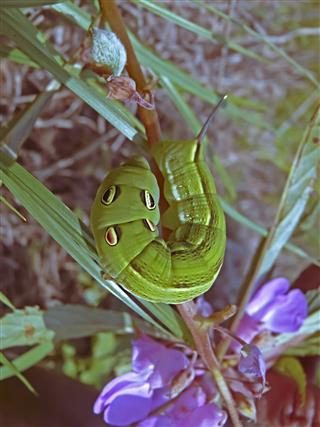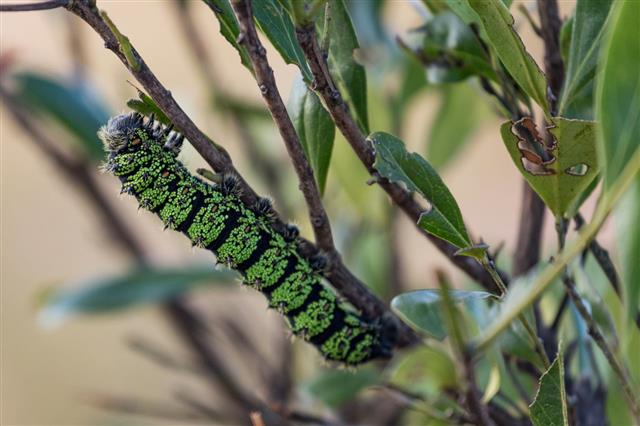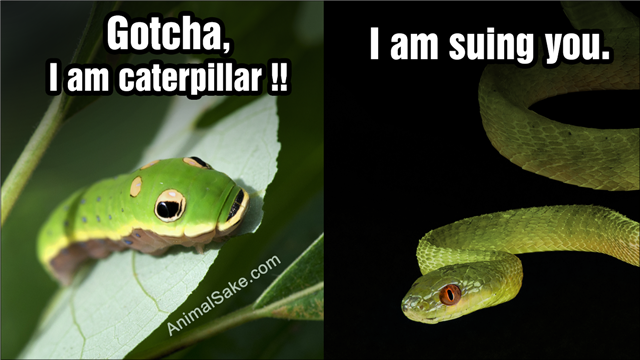
Identifying caterpillars can be a real challenge, as most of them do not resemble adult butterflies. Here is a brief overview about some of the most common types of caterpillars and their characteristic features.
Quick Snippet
- Various types of caterpillars have setae and spines, but only a few species have stinging hair. Avoid direct contact with such caterpillars, if you cannot identify the venomous ones.
- Caterpillars represent an important stage in the life cycle of butterflies and moths. The life cycle of these insects consists of four separate stages – eggs, caterpillars (larvae), pupae, and adults.
Caterpillars represent the larval stage of butterflies and moths. Various other insects have larval stages in their life cycles. Those insect larvae may also resemble caterpillars. Distinguishing such insect larvae from caterpillars, can be a tough task. Given the huge number of butterflies and moth species, identifying a specific type can also be difficult.
How to Identify a Caterpillar
- In general, almost all caterpillars have some common physical features.
- They have tubular bodies, which are segmented.
- Most of them have three pairs of true legs on their thoracic segments.
- The number and location of prolegs on the abdominal segments may differ from one type to another.
- Some types of caterpillars have their bodies covered with hair.
Muscular Body
Studies show that a caterpillar has around 4000 muscles in its body, and its movement is facilitated by contraction of muscles in the rear parts.
How Do Caterpillars Breathe
Butterfly larvae breathe through tiny pores, that are located along the sides of thoracic and abdominal segments. Some types of caterpillars have gills, so that they can lead an aquatic life.
Can Caterpillars See?
Caterpillars have a good eyesight, as they possess around six, small eyelets.
How Do Caterpillars Feed ?
They can sense vibrations and locate food using their antennae. Their mouths are also strong enough to chew food. While most of them feed on plant matter, some caterpillars eat insects.
Caterpillars, Worms, and Other Insect Larvae
- Caterpillars and worms have soft bodies, but there is one noticeable difference between the two. It is the presence of legs in caterpillars (worms lack such appendages).
- Other indentification is their prolegs. Most of the insect larvae, other than caterpillars have prolegs on each and every body segment.
- Usually, five pairs of prolegs are found on the abdominal segments of caterpillars. Caterpillars have grasping hooks attached to their prolegs, and this feature is absent in other insect larvae.
Lepidopteran Larvae Identification Tips
Caterpillar identification is not that easy, as the order Lepidoptera (consists of butterflies and moths) has more than 150,000 species that fall under 126 families. It is almost impossible to develop awareness about caterpillars of each and every species. While some have dense hair on their bodies, others have warts, spikes, spots, lines, etc. Some species are exclusively found on certain plants and trees. Commonly found caterpillars are classified on the basis the families they belong to.
Family: Geometridae (Geometer Moths)
Members of this family are called geometer moths and their larvae are known as inchworms, spanworms, or loopers.
These names are derived from the nature of their movement. A moving inchworm looks as if it is measuring the surface.
Physical Characteristics
Unlike other caterpillars, loopers have their prolegs concentrated on both ends of their bodies. So, they form loops, while clasping a surface with their posterior and anterior parts. Most of the loopers have excellent camouflaging skills and are green, gray, or brown. Some of them stand erect like twigs, when threatened.
Family: Hesperiidae (Skippers/Darters)
Unlike loopers, the name skipper is derived from the darting habit of adult butterflies in this family. Caterpillars that belong to the Hesperiidae family have certain characteristic features. Most of the skipper larvae have large heads and constricted necks.
Usually, the body of a skipper larva is wider near the abdomen and tapers to the anal part.
Physical Characteristics
Skipper/Darter caterpillar has an anal comb, that helps to expel excreta away from its shelter and feeding places. The ring-like segments on the body of this caterpillar are covered with minute hair. Skipper caterpillars are mostly nocturnal and create shelters by folding leaves. Most of them have a single body color.
Family: Sphingidae (Hawk Moths)
Caterpillars of hawk moths that belong to the Sphingidae family are called hornworms.
The name of this caterpillar is derived from the horn-like appendage on the posterior part of its abdomen, usually on the eighth abdominal segment. Each segment on its body has shallow creases.
Physical Characteristics
Hawk moths caterpillar has flat anal prolegs that form a triangle beneath the anal plate. Most of the hornworms are found to descend to the ground for pupation. They are among the largest and most common caterpillars in many regions.
Family: Saturniidae (Regal Moths, Silk Moths)
The family Saturniidae too has some of the largest caterpillars with long setae, horns, and knobs. The caterpillars of regal moths (Citheronia regalis) that belong to the subfamily Ceratocampinae, are called hickory horned devils.
Physical Characteristics
In general, a silk moth caterpillar has a large body, which can be around 3 to 4 inches in length; most of these caterpillars have scoli (branched and thickened spines) along their back and sides. They live on trees and shrubs and descend to the ground during late summer and spin cocoons among the debris, which can be used to make silk fabric, thus, they are called silkworms. The quality of these cocoons are not as good as that of Bombyx Mori.
Family: Papilionidae (Swallowtails)
This family has some of the largest and colorful butterflies in the world.
The common name swallowtails is derived from their forked hind wings.
The caterpillars of these butterflies are mostly brightly colored with very fine hair on their bodies.
Physical Characteristics
Most of them have retractable tentacles with scent glands, which are used to scare away intruders. So, the main characteristic feature of the swallowtail caterpillars is the ‘osmeterium’, the forked and fleshy organ in the second segment of their bodies. The broadest part of the body of a swallowtail caterpillar is the thoracic-abdominal juncture.
Family: Lymantriidae (Tussock Moths)
The name tussock moth is derived from the dense tufts of hair found on its larvae. Most of the tussock moth larvae are attractive and distinct with hairy projections on their bodies. The body hair of these caterpillars comes off easily, and may trigger allergic reactions in some people, if they come into contact with their skin. This is considered as a defensive mechanism of these larvae. Even their cocoons have a good amount of body hair incorporated in them.
Family: Arctiidae (Tiger Moths, Lichen Moths, Wasp Moths)
Tiger moths are members of the family Arctiidae and their caterpillars are commonly referred to as woolly bears or woolly worms. The name is derived from the dense hair that cover their bodies. Larvae of some species feed on lichens and moss, and they are mostly hairless. Most of the tiger moth caterpillars have brightly colored bodies and are mainly found during fall, when they are in search of an ideal location for hibernation.
Physical Characteristics
These caterpillars are found to indulge in basking, so as to boost digestion.
If they feel threatened, most of the woolly bears roll their bodies like balls.
Caterpillars of lichen moths are dark-colored and have dark hair on their bodies. Some may have tufts of hair on their back.
Caterpillars of some species are called tussock moths, but the name is used to denote the larvae of the family Lymantriidae.
Family: Notodontidae (Prominents)
This is a family of large moths that are commonly known as prominents. The common name is derived from the projecting wing tufts in adults and the dorsal humps in larvae. Most of these caterpillars have colorful and hairless bodies, tubercules, and spines or humps. They are known for their bizarre shapes and the ability to attack intruders with acid ejected from a gland located on the lower side of the thoracic segment.
Physical Characteristics
The defense mechanism is not seen in all species. Prominent caterpillars have secondary setae above the mid-abdominal prolegs. The anal prolegs are either too short, or too long and tail-like. Most of these caterpillars keep the posterior and anterior parts of their bodies raised, while resting. They can be easily identified by these characteristic features.
Family: Limacodidae (Slug Moths/Cup Moths)
This family of moths have some of the most weird-looking caterpillars. They are named slug moth caterpillars, because their larvae look like slugs. The name cup moth is derived from the shape of their cocoons. Most of the species have flat-bodied larvae with suckers in place of prolegs.
Physical Characteristics
Slug Moths/Cup Moths caterpillars are usually green and smooth and they move in wavy motions. However, the family has other species of bright-colored caterpillars with tubercles and urticating hair. Most of the slug moth caterpillars have their heads hidden or retracted into their thoracic folds.
Family: Lasiocampidae (Eggars/Snout Moths/Lappet Moths)
This family of moths has around 200 species. The name snout moths is derived from the pointed snouts in adults, who are also called eggars because of their egg-shaped cocoons. The hairy caterpillars of these species have skin flaps on their prolegs, and hence the name lappet moths. Hair is mainly concentrated on the sides of their bodies. In some species, caterpillars live together inside nests spun with silk. So, they are called tent caterpillars.
Family: Noctuidae (Owlet Moths)
This is the largest family in the order Lepidoptera (moths and butterflies) and are called cutworms. There are around 35,000 known species, and their caterpillars are so diverse to be classified on the basis of similar features. In general, these caterpillars have stout bodies and inconspicuous setae. Some are hairy like tiger moth caterpillars.
This is only a brief overview about some of the commonly found caterpillars, classified on the basis of families. It is best to develop an awareness about the local species, especially pests and poisonous caterpillars. You may conduct a deep study about the commonly found caterpillars in your area, so that you can identify them easily.

















